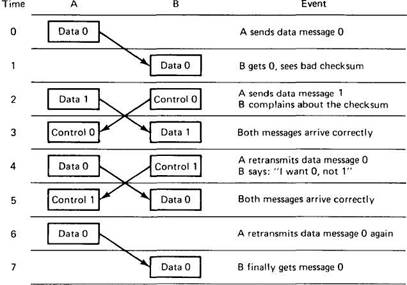Книга: Distributed operating systems
2.1.2. The Data Link Layer
2.1.2. The Data Link Layer
The physical layer just sends bits. As long as no errors occur, all is well. However, real communication networks are subject to errors, so some mechanism is needed to detect and correct them. This mechanism is the main task of the data link layer. What it does is to group the bits into units, sometimes called frames, and see that each frame is correctly received.
The data link layer does its work by putting a special bit pattern on the start and end of each frame, to mark them, as well as computing a checksum by adding up all the bytes in the frame in a certain way. The data link layer appends the checksum to the frame. When the frame arrives, the receiver recomputes the checksum from the data and compares the result to the checksum following the frame. If they agree, the frame is considered correct and is accepted. It they disagree, the receiver asks the sender to retransmit it. Frames are assigned sequence numbers (in the header), so everyone can tell which is which.
In Fig. 2-3 we see a (slightly pathological) example of A trying to send two messages, 0 and 1, to B. At time 0, data message 0 is sent, but when it arrives, at time 1, noise on the transmission line has caused it to be damaged, so the checksum is wrong. B notices this, and at time 2 asks for a retransmission using a control message. Unfortunately, at the same time, A is sending data message 1. When A gets the request for retransmission, it resends 0. However, when B gets message 1, instead of the requested message 0, it sends control message 1 to A complaining that it wants 0, not 1. When A sees this, it shrugs its shoulders and sends message 0 for the third time.

Fig. 2-3. Discussion between a receiver and a sender in the data link layer.
The point here is not so much whether the protocol of Fig. 2-3 is a great one (it is not), but rather to illustrate that in each layer there is a need for discussion between the sender and the receiver. Typical messages are "Please retransmit message n," "I already retransmitted it," "No you did not," "Yes I did," "All right, have it your way, but send it again," and so forth. This discussion takes place in the header field, where various requests and responses are defined, and parameters (such as frame numbers) can be supplied.
- 2.1.4.The Transport Layer
- 2.1.5. The Session Layer
- 2.1.7. The Application Layer
- Transport Layer
- Code on the Net
- Информация заголовочной страницы (Database header)
- Database dialect
- 4.4.4 The Dispatcher
- DATABASE CACHE SIZE
- About the author
- Chapter 7. The state machine
- Appendix E. Other resources and links




